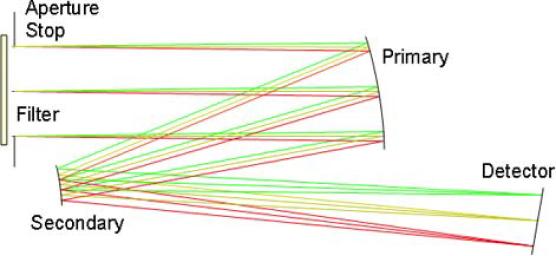
|
Get the NAC
- Click the image above for a larger view
- Full-Res JPEG (471 x 217) (16.8 kB)
- Full-Res TIFF (471 x 217) (307.0 kB)
Caption:
This figure is a ray-tracing diagram from the optical design of the MDIS Narrow Angle Camera (NAC). The NAC has a 1.5° field of view, a focal length of 550 mm, and a 24-mm aperture (resulting in an f/22 system). It uses an off-axis Ritchey-Chretien design. The ellipsoidal primary mirror and hyperboloidal secondary mirrors are gold-coated aluminum. A bandpass filter is the first optical component of the assembly. This filter defines the spectral range of the instrument. A specially designed interference coating serves as a heat-rejection filter, preventing the substantial infrared radiation emitted by the surface of Mercury from entering the instrument and heating the detector (CCD).
The diagram and description of the NAC are taken from a paper titled "The Mercury Dual Imaging System on the MESSENGER spacecraft," published in the journal Space Science Reviews , vol. 131, pages 247-338, in 2007. The lead author is the MDIS Instrument Engineer, S. E. Hawkins.
Background Info:
The MESSENGER spacecraft is the first ever to orbit the planet Mercury, and the spacecraft's seven scientific instruments and radio science investigation are unraveling the history and evolution of the Solar System's innermost planet. MESSENGER acquired over 150,000 images and extensive other data sets. MESSENGER is capable of continuing orbital operations until early 2015.
For information regarding the use of images, see the MESSENGER image use policy .
Cataloging Keywords:
| Name | Value | Additional Values |
|---|---|---|
| Target | Mercury | |
| System | ||
| Target Type | Planet | |
| Mission | MESSENGER | |
| Instrument Host | MESSENGER | |
| Host Type | Orbiter | |
| Instrument | Mercury Dual Imaging System (MDIS) | |
| Detector | Narrow Angle Camera (NAC) | |
| Extra Keywords | Color, Infrared, Radio | |
| Acquisition Date | ||
| Release Date | 2013-04-23 | |
| Date in Caption | ||
| Image Credit | NASA/Johns Hopkins University Applied Physics Laboratory/Carnegie Institution of Washington | |
| Source | photojournal.jpl.nasa.gov/catalog/PIA16998 | |
| Identifier | PIA16998 | |
